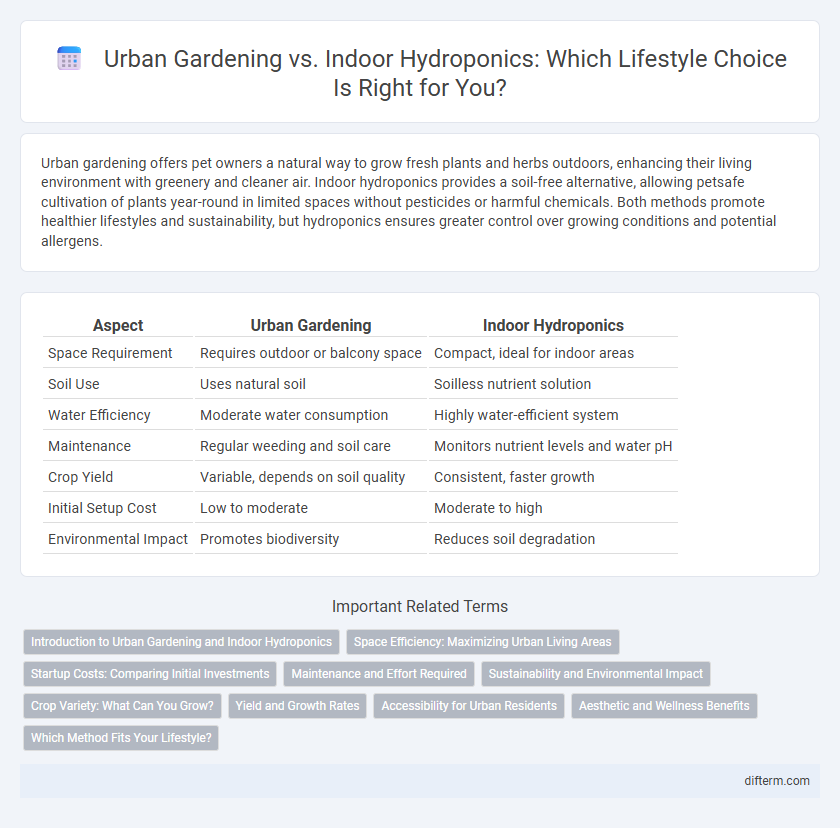Urban gardening offers pet owners a natural way to grow fresh plants and herbs outdoors, enhancing their living environment with greenery and cleaner air. Indoor hydroponics provides a soil-free alternative, allowing petsafe cultivation of plants year-round in limited spaces without pesticides or harmful chemicals. Both methods promote healthier lifestyles and sustainability, but hydroponics ensures greater control over growing conditions and potential allergens.
Table of Comparison
| Aspect | Urban Gardening | Indoor Hydroponics |
|---|---|---|
| Space Requirement | Requires outdoor or balcony space | Compact, ideal for indoor areas |
| Soil Use | Uses natural soil | Soilless nutrient solution |
| Water Efficiency | Moderate water consumption | Highly water-efficient system |
| Maintenance | Regular weeding and soil care | Monitors nutrient levels and water pH |
| Crop Yield | Variable, depends on soil quality | Consistent, faster growth |
| Initial Setup Cost | Low to moderate | Moderate to high |
| Environmental Impact | Promotes biodiversity | Reduces soil degradation |
Introduction to Urban Gardening and Indoor Hydroponics
Urban gardening transforms city spaces into productive green areas by utilizing small balconies, rooftops, and community plots to grow fruits, vegetables, and herbs. Indoor hydroponics offers a soil-free method that uses nutrient-rich water solutions, enabling year-round crop cultivation in controlled environments such as apartments and offices. Both approaches promote sustainable food production, improve air quality, and provide fresh, organic produce to urban dwellers.
Space Efficiency: Maximizing Urban Living Areas
Urban gardening maximizes limited outdoor spaces such as balconies and rooftops, utilizing vertical planters and container gardens to grow vegetables and herbs effectively. Indoor hydroponics optimizes space by allowing soil-less plant cultivation in compact, stacked systems within small apartments or rooms, enabling year-round growth regardless of climate. Both methods enhance urban living by transforming underused areas into productive green spaces, promoting sustainability and fresh food access.
Startup Costs: Comparing Initial Investments
Urban gardening typically requires lower initial investment, involving basic tools, soil, and seeds, making it accessible for beginners. Indoor hydroponics demands higher startup costs due to specialized equipment like grow lights, pumps, and nutrient solutions, driving expenses up to several hundred dollars. Entrepreneurs aiming to balance cost and efficiency often consider long-term yield and space constraints when choosing between these cultivation methods.
Maintenance and Effort Required
Urban gardening demands regular soil care, watering, and pest control, requiring consistent physical effort and time investment. Indoor hydroponics offers a controlled environment with automated nutrient delivery and water management, significantly reducing manual maintenance. While urban gardening fosters traditional hands-on interaction, hydroponics streamlines growth processes, ideal for those seeking low-maintenance plant cultivation.
Sustainability and Environmental Impact
Urban gardening enhances sustainability by promoting local food production, reducing transportation emissions, and improving air quality through increased greenery. Indoor hydroponics conserves water efficiently, minimizes pesticide use, and allows year-round crop cultivation with a smaller land footprint. Both methods contribute to reducing carbon footprints but differ in resource use and scalability within urban environments.
Crop Variety: What Can You Grow?
Urban gardening supports a wide range of crops, including root vegetables, herbs, and leafy greens suited to soil-based growth and outdoor conditions. Indoor hydroponics enables year-round production of high-yield crops like lettuce, tomatoes, strawberries, and herbs in controlled environments without soil. Hydroponic systems often maximize space efficiency, allowing for denser planting and optimized nutrient delivery to diverse plant varieties.
Yield and Growth Rates
Urban gardening and indoor hydroponics offer distinct advantages in yield and growth rates; hydroponics typically delivers faster plant growth by up to 25-50% due to nutrient-rich water solutions and controlled environments. Urban gardening relies on soil quality and seasonal factors, which can limit consistent yield but promotes biodiversity and soil health. Hydroponic systems maximize space efficiency and water usage, making them ideal for high-density urban settings seeking rapid and abundant harvests.
Accessibility for Urban Residents
Urban gardening offers city residents direct access to soil and sunlight, making it a natural choice for those with balcony space or small yards. Indoor hydroponics provides a space-efficient alternative that requires limited physical labor and allows for year-round cultivation regardless of outdoor conditions. Both methods enhance food security and sustainability, but indoor hydroponics may be more accessible for residents lacking outdoor space or dealing with urban pollution.
Aesthetic and Wellness Benefits
Urban gardening enhances outdoor aesthetics with vibrant greenery and seasonal blooms, creating a refreshing natural escape that promotes mental well-being through direct sunlight and fresh air exposure. Indoor hydroponics offers a sleek, space-efficient solution with year-round plant growth, improving indoor air quality and reducing stress by incorporating lush greenery into modern living spaces. Both methods contribute to wellness by fostering a connection to nature, yet urban gardening emphasizes outdoor sensory experiences while hydroponics excels in controlled environments for aesthetic harmony and health benefits.
Which Method Fits Your Lifestyle?
Urban gardening offers a hands-on, soil-based approach ideal for those with outdoor space and a preference for traditional cultivation, while indoor hydroponics suits busy individuals seeking efficient, soil-free growth with precise control over nutrients and environment. Urban gardening enhances connection with nature and seasonal cycles, whereas indoor hydroponics maximizes yield year-round with minimal space. Choosing between these methods depends on available space, time commitment, and desired level of involvement in plant care.
Urban gardening vs Indoor hydroponics Infographic

 difterm.com
difterm.com